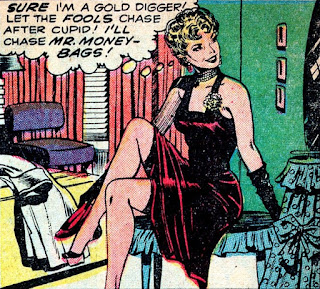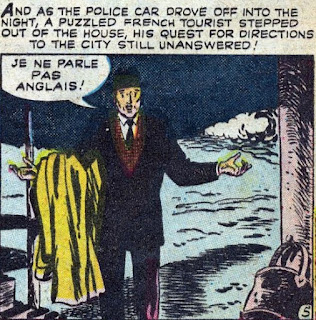Horror Comics
Journey Into Mystery 23
“Yvette” (a: Marvin Stein) ★★
“Revenge!” (a: Ed Winiarski) ★★★
“The Doll House!” (a: Gene Colan) ★★1/2
“Clinging Vine” (a: Manny Stallman) ★★1/2

From that moment on, Vasily’s only focus is killing his betrayer. One night, Vasily sees Gregorivitch marched into a small cabin and recognizes his best chance at evening up the score. He sneaks into the building and stabs Ivan to death. Too late, Vasily realizes he followed his enemy into the gas chamber. At least one thing will remain constant as we slip away from the pre-code and gird ourselves for the post-code years: the big, bad commies. Winiarski’s art remains crude but, at times, effective.
 With the coming of the code and the banishment of werewolves, vampires, and other nasty juvenile-delinquency feeders, Stan and the boys were forced to come up with new ideas focusing on psychology and the spirit world. Paul S. Newman’s “The Doll House” is a perfect example of the new norm. Twelve-year old Nancy is still obsessed with her childhood doll house and its occupants and that makes her parents nervous. They take the house away from their daughter and place it in storage in the attic. A decade later, a newly-wed Nancy returns to the attic to find the dolls inside have aged and the house has become run-down and decrepit. The finale is too abrupt (but, of course, we are talking about a four-page strip here) and the startling revelation is left unexamined, but “The Doll House” succeeds because of its eerie atmosphere.
With the coming of the code and the banishment of werewolves, vampires, and other nasty juvenile-delinquency feeders, Stan and the boys were forced to come up with new ideas focusing on psychology and the spirit world. Paul S. Newman’s “The Doll House” is a perfect example of the new norm. Twelve-year old Nancy is still obsessed with her childhood doll house and its occupants and that makes her parents nervous. They take the house away from their daughter and place it in storage in the attic. A decade later, a newly-wed Nancy returns to the attic to find the dolls inside have aged and the house has become run-down and decrepit. The finale is too abrupt (but, of course, we are talking about a four-page strip here) and the startling revelation is left unexamined, but “The Doll House” succeeds because of its eerie atmosphere.Orde Wilson is convinced that mankind’s next great war will be with ivy! The “Clinging Vine,” Orde claims, has a brain and is plotting the takeover of Earth. Orde details the history of ivy to anyone who will listen but, usually, the reaction is laughter, not awe. Finally, Orde goes too far when he attacks a wall of ivy and is arrested. That night, our unsung hero is strangled in his cell; the authorities have no idea who the culprit is, even as tendrils of ivy pull back through the jailhouse window. Another fanciful yarn, with some solid Stallman graphics, but too much of this reads like a Wikipedia entry on ivy.-Peter
Marvel Tales 132
“Poison Pen!” (a: John Tartaglione) ★★
“The Old Couple!” (a: Sid Greene) ★★
(r: Tomb of Darkness #23)
“Hail the Hero” (a: Robert Q. Sale) ★★★★
“The Man Who Lost Yesterday!” (a: Ed Winiarski) ★1/2
“The Man Who Wasn’t” (a: Dick Ayers) ★1/2
Bessie and John fall asleep in front of the fire while remembering the good old days. Bessie wakes up from her nap, but John has drifted into the eternal sleep, never to awaken. After a brief viewing ceremony, Bessie is left alone with John’s corpse in her living room. Feeling a chill, she descends into the basement to bring up more wood for the fire. There, she sees a younger John beckoning to his wife to join him. “The Old Couple” are reunited again!
In the future, spacemen are not allowed to marry. That causes some discomfort for Desmond, the world’s most adept outer space pilot, who has fallen in love with the gorgeous Dina. In steps Desmond’s best buddy, Clarke, who convinces Desmond to forget Dina and concentrate on chasing immortality. That’s, of course, because Clarke has fallen hard for the fetching femme. Desmond blasts off for the moon and then to Mars and then to Saturn and on and on while Clarke stays back on Earth and marries Dina. Years later, jobless and married to an overweight couch potato, Clarke stares out the window and wonders what might have been.
Though the code has clipped the violence and monsters from the Atlas stable, it hasn’t yet diminished the acidic wit the bullpen could write into their scripts from time to time. Clarke’s closing monologue (”What a fool I was!… All because of a woman… a woman who turned into a shrew, who aged quickly, who speaks only of Desmond and looks on me as a worm!”) is more effective poetic justice than a dozen resurrected corpses. “Hail the Hero” is a darkly funny sci-fi tale with some nice Sale art.
In “The Man Who Lost Yesterday,” a murderer tries to remember what happened after he rubbed out his business partner. The fog clears when he realizes he’s a ghost, killed by police while fleeing the scene. Equally disappointing (and confusing to boot) is “The Man Who Wasn’t,” which spotlights Charlie Correl, an inventor working on a new toy rocket. Charlie is aided by his next-door neighbor, the mysterious Mr. Manley who, we later find out, is from the future. Scientists have sent Manley back into the past to help invent a new “principle of levitation” and stall the end of mankind. I’d tell you more but it’s not really worth it and, to be honest, I didn’t quite understand Manley’s logic anyway. In the trivia department, “The Man Who Wasn’t” might well be the most over-used (and dumb) title in the Atlas horror/sci-fi titles, having been utilized at least three times prior.-Peter
Mystery Tales 27
“The Buildings That Vanished!” (a: Dick Ayers & Ernie Bache) ★★★
“Feet of Clay” (a: Ross Andru and & Mike Esposito) ★★
“Costume Party” (a: Ed Winiarski) ★1/2
“Lonely Hearts” (a: John Forte) ★★1/2
“Welcome Home!” (a: Al Hartley) ★1/2
 At a "Costume Party" meeting of the Science-Fiction Cartoonists League, the guests are all dressed like aliens from other planets. League President Burke shows up in a suit and tie and explains that aliens would surely arrive disguised as humans. His fellow members toss him into the backyard pool, only to see another alien arrive. He is unmasked as Burke, and they see a spaceship taking off from the pool.
At a "Costume Party" meeting of the Science-Fiction Cartoonists League, the guests are all dressed like aliens from other planets. League President Burke shows up in a suit and tie and explains that aliens would surely arrive disguised as humans. His fellow members toss him into the backyard pool, only to see another alien arrive. He is unmasked as Burke, and they see a spaceship taking off from the pool.Mystic 36
“The Warning!” ★
(r: Journey Into Mystery #15)
“The Hands of the Clock!” (a: Art Peddy) ★
“The Eavesdropper!” (a: Vince Colletta) ★
(r: Dead of Night #8)
“The World Champion” ★1/2
Mary is startled to see that her old friend, Helen, who used to beg for loans, is now loaded with cash. What’s her secret? Helen won’t tell, so Mary follows her and discovers that this newfound wealth is due to Helen having saved a blind beggar’s life and being granted one wish. Not one for originality (or working for an honest buck), Mary arranges for a near-accident and she’s in the right place at the right time to save the blind beggar. When the man grants her one wish, Mary wishes she was the “most beautiful and richest queen of them all!” Suddenly, Mary is hurtled back through the ages and finds herself sitting on a throne. Mary’s ecstatic until she exits the castle and an unruly mob rushes Marie Antoinette to the guillotine.
“Which Wish, Dish…?” contains some nice Jay Scott Pike art and a clever twist, but I’d like to know exactly how Helen phrased her wish. This was Pike’s 15th and final pre-code tale, but the artist would go on to contribute 15 more times during the Atlas/Marvel post-code years of 1955-57.
Ludwig, the clockmaker, goes on a rampage and almost murders one of his customers for abusing his clock. Later, after the police leave, Ludwig breaks into the man’s house to “feed” the clock and is arrested. Behind bars, Ludwig dies and the medical examiner discovers that the dead man is a clock as well. Ludicrous and, like “The Warning,” a tale told way too many times. Even more dull is “The Eavesdropper,” wherein a con man overhears a planned murder and attempts to blackmail the would-be assassins. Of course, in the climactic panel, we discover the dope has eavesdropped on his own murder. Artist Vince Colletta was just getting his start at Atlas when the bottom dropped out. He had a total of 10 stories appear in the various titles and would see 11 more tales of mystery and suspense in Atlas’s post-code material. Of course, Colletta went on to fame as a big-name inker at both Marvel and DC (enjoying a very long stint as Jack Kirby’s assistant on Journey Into Mystery/The Mighty Thor) for more than two decades.
When one athlete wins every event in the Olympics, thousands cheer in admiration until the man opens his mouth and reveals he’s a Martian. The Red Planet deemed it a good idea to show what stamina their inhabitants possess before the big invasion. But when a female fan lays a big kiss on “The World Champion,” he drops dead from the bacteria. The War of the Worlds is shamelessly plagiarized not once but twice in the same issue! To anyone paying attention, gone were the zombies, werewolves, and vengeful corpses. The artistic pabulum courtesy of the post-Senate hearings had been fully introduced.-Peter
Cover by Carl Burgos
(r: Vault of Evil #12) ★★
“The Albatross!” (a: Pete Tumlinson) ★1/2
(r: Vault of Evil #14)
“The Barefoot Man” (a: Robert Q. Sale) ★1/2
(r: Giant-Size Werewolf #2)
“Deep Down” (a: Art Peddy) ★
(r: Dead of Night #5)
“Sarah” (a: Joe Sinnott) ★1/2
(r: Dead of Night #6)
A sidewalk toy salesman thinks he's hit it big when he finds a bunch of self-winding mechanical men. He charges fifty cents a piece and sells out, but that night he discovers more toy men in his valise then he thought he had. Back on the street the next day, his customers from the day before complain that the toys walked off on their own! He runs down an alley, the valise falls open, and one of the toy men shoots him with a ray gun. Next thing he knows, he's on another planet being sold as a unique mechanical giant toy!
"The Albatross!" retells "The Rime of the Ancient Mariner" with a modern-day crew. Pete Tumlinson's art is average at best and the only "uncanny" thing about this tale is that the seaman telling it turns out to be a ghost at the end. Yawn.
Pablo, "The Barefoot Man," wishes he had a pair of boots. Oh, the places he could go and the things he could do if only he were shod! One day, he murders a traveler on the road and steals the man's fine boots. He is soon apprehended by Federales, who tracked the boot prints in order to catch the man who wore them--a robber and a murderer! No one listens to Pablo's protestations of innocence.
So far, these tales aren't very uncanny and the art isn't very good. It's surprising that all five stories in this issue were reprinted in Marvel horror comics of the 1970s.
















No comments:
Post a Comment